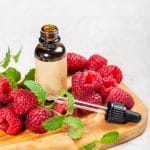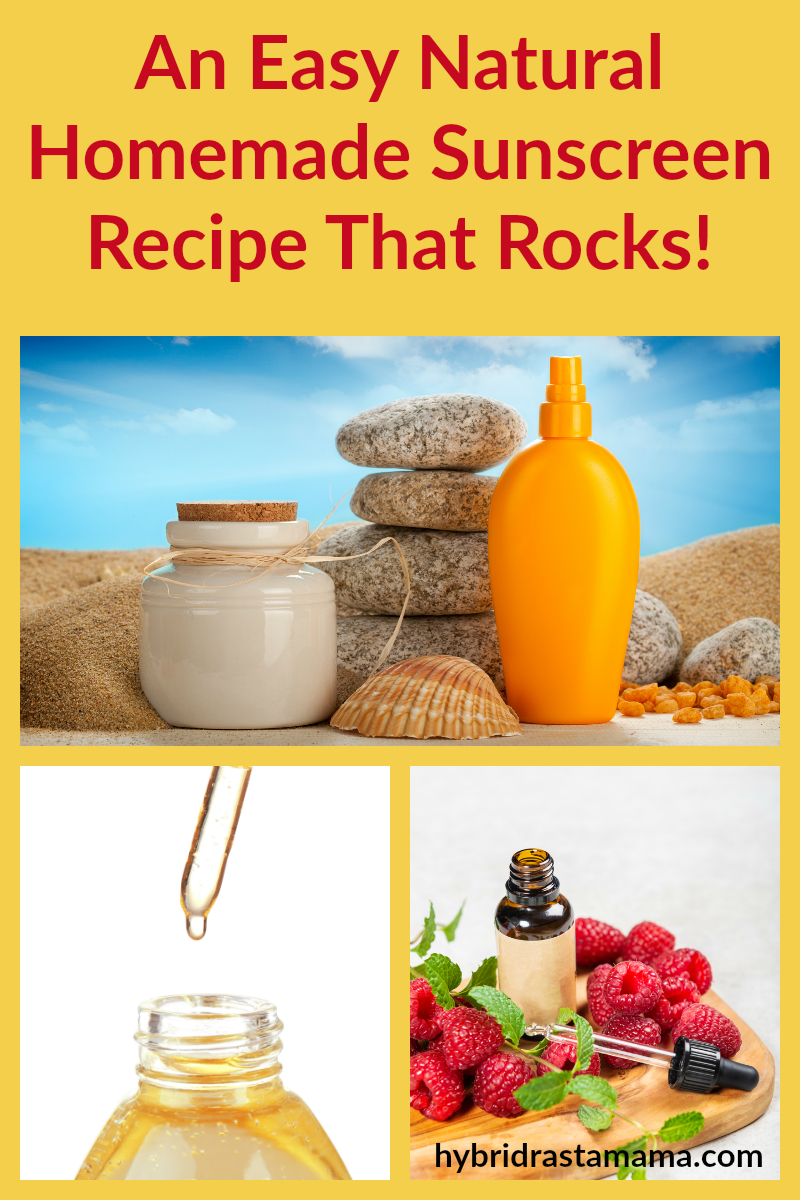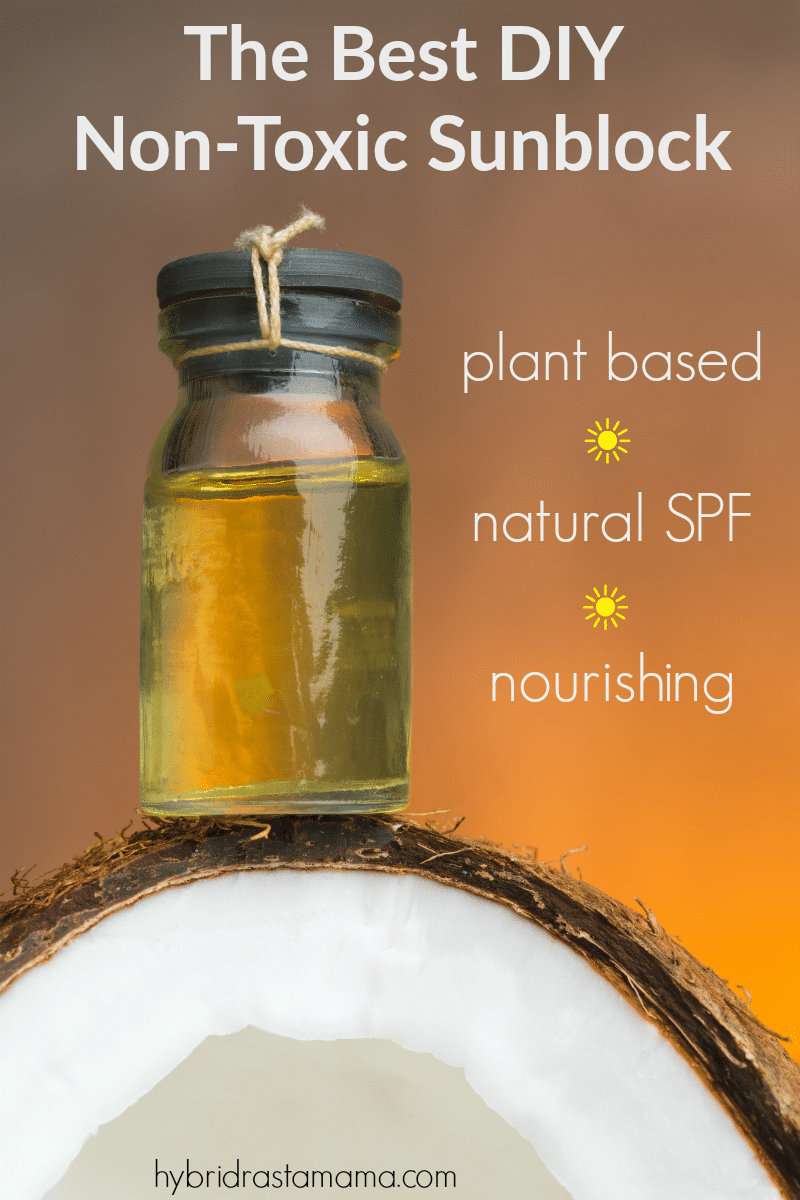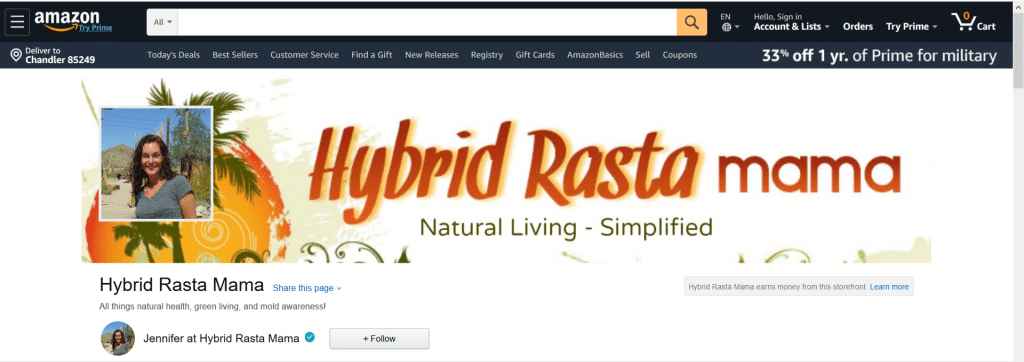So you want to make your own sunscreen but don’t know where to start? You don’t want to end up with a goopy mess that turns you white but at the same time you want to make sure that your homemade sunscreen recipe offers high SPF protection.
An Easy Natural Homemade Sunscreen Recipe That Rocks
I started making my own sun protection years ago. I was shocked to see that it actually worked. All those years of using toxic sunscreens in SPF 100 and I still burned. Hangs head in shame. If only I had known then…
But hindsight is 20/20 and I am thrilled to have found a combination of ingredients that works for my entire family! Everyone I know that has used this sunscreen recipe has loved it. No burns. And for those individuals who do get a little pink, it never turned into anything beyond a bit of a flushed look for a few hours. I’m not promising any specific results for you or your family members so be sure to exercise caution when you first start using this. But I suspect you will be glad you tried this recipe!
Before I get to my natural sunscreen recipe, you need to do a little light reading. An important factor in preventing skin damage of any kind from too much sun exposure is understanding your skin type and your resulting SPF needs. So head over to my post on Coconut Oil For Sun Protection. That will give you the scoop on how to safely interact with the sun based on your skin type.
Homemade Sunscreen Ingredients
You are probably wondering WHY I choose the ingredients I did for my easy sunscreen recipe. In short, it’s all about the SPF and ease of use. I personally have no desire to turn white from my sunblock nor do I want to spend an hour in the shower scrubbing it off.
This sunscreen recipe results in a very creamy sunblock that absorbs into your skin. No worrying about scrubbing it off. In fact, leaving it on offers additional skin benefits. Win-win.
So let’s look at the main sunscreen ingredients shall we?
Coconut Oil
Coconut oil has an amazing ability to heal the skin and block the damaging effects of UV radiation from the sun. One of the reasons why it is so effective in protecting the skin is its antioxidant properties, which helps prevent burning and oxidative damage that promotes skin cancer. There have been several recent studies done on the use of coconut oil as a sunscreen but there are fluxuations in the SPF rating of coconut oil. One study “proved” a rating of only 4 while another rated coconut oil at a 10. However, coconut oil alone does not offer enough sun protection. That is why I rely on two other plant oils.
To learn more about coconut oil and all of it’s benefits and uses, visit my Coconut Health Page.
Carrot Seed Oil
Carrot seed oil is an essential oil with significant antioxidant, antiseptic, antifungal and fragrant properties with high levels of vitamin A. When applied topically to the skin in the form of a diluted carrier oil, carrot seed oil also provides natural sun protection. Carrot seed oil has a natural SPF of 38 and 40.
To get the full scoop on how incredible carrot seed oil is, check out my post about The Secret World Of Carrot Seed Oil.
This is my favorite carrot seed oil.
Red Raspberry Seed Oil

This is my favorite red raspberry seed oil.
Vitamin E Oil
I mainly add Vitamin E Oil as a natural preservative but it does nourish and protect the skin.
Shea Butter / Mango Butter / Cocoa Butter
While not an oil, shea butter is derived from the fat of the shea nut. Shea butter melts at body temperature and absorbs rapidly into the skin without leaving a greasy feeling. It contains the antioxidants, vitamins A and E both of which enhances skin cell regeneration and promote blood circulation below the skin’s surface. Cinnamic acid in the oil provides vital protection against harmful UV rays. Its rich emollient quality makes it excellent for very dry skin. SPF 0-8. This is the shea butter I use.
Cocoa butter is the natural fat extracted from the cacao bean from South America and West Africa. The cocoa butter creates a shield against the environment meaning it helps keeps harmful UV rays out. Cocoa butter has excellent moisturizing benefits. The oils within the butter lock in water close to the skin, keeping it hydrated all day long. This ensures that your skin doesn’t dry out, which can do more harm than good. SPF 0-8. The is the cocoa butter I use.
Mango Butter is believed to provide natural protection from ultraviolet (UV) radiation although it’s specific SPF is unknown. Mango butter helps keep skin hydrated. Mango butter is also an effective after-sun treatment to restore moisture and heal sun-damaged skin. It has a LONG shelf life which actually makes it a natural preservative as well. This is the mango butter I use.
Ingredient Alternative – Cupuacu Seed Butter
Capuacu seed butter is not a butter I list in the recipe ingredients but it is a worthy opponent to shea butter, mango butter, and cocoa butter. It can be difficult to source and a little pricey however and because it is so light, it does change the sunscreen texture slightly. If you do want to use cupuacau seed butter in place of the other butters, please know that while the sunscreen will still absorb quickly, initially it might seem a bit more liquidy.
Due to its reputation and nutrient contents, cupuaçu has been considered ‘the king of superfruits’ due to its high antioxidant concentration. The superfruit has lots of omega fatty acids and anti-oxidizing polyphenols, in addition to essential vitamins and nutrients such as B vitamins, amino acids, flavanoids, calcium, selenium and at least nine antioxidants including Vitamins A and C. As an added bonus, cupuaçu provides a protective barrier against UV rays, helping to prevent skin damage due to the sun.
Cupuacau has a large capacity for water absorption, as well as preventing the evaporation of water loss through the skins tissue, making it a perfect ingredient for dry, dehydrated skin. It also has wonderful moisturising properties, helping to restore the skin’s own natural moisture.
This is my favorite cupuacau seed butter.
Can I Use This Natural Homemade Sunscreen On My Face?
Yes you can! It is actually awesome for your face, especially the carrot seed oil.
Is This Sunscreen Recipe Waterproof?
Not really. However, the Beeswax does add waterproof properties. I would always suggest reapply this sunblock after getting in the water.
* THIS sunscreen recipe worked for ME and for many of my friends. However, skin tone, condition of skin, altitude, time spent in the sun, time of day, whether or not you are in the water, etc… can all factor into how well this recipe will work. Please experiment with this sunscreen before spending 8 hours at the beach using only this! In addition, I cannot give you a firm SPF rating for this recipe. This is because the SPF ratings for the plant oils and butters vary.*

Sunscreen Recipe Using Coconut Oil, Carrot Seed Oil, and Raspberry Seed Oil
Looking for a DIY non-toxic sunscreen recipe? This easy to make, amazing to use recipe contains some of nature's best oils. It will leave you sun-kissed but not sun burned.
Materials
- 1 ounce coconut oil
- 1 ounce beeswax (adds waterproof properties but does not make it 100% waterproof)
- 1 ounce butter (i.e. shea butter, mango butter, or cocoa butter)
- 20 drops of carrot seed oil
- 1/2 ounce raspberry seed oil
- 1 teaspoon vitamin E oil
Instructions
- In a double boiler, over low heat, melt the coconut oil, beeswax, and butters.
- Remove from heat and allow to cool slightly prior to adding the carrot seed, red raspberry, and vitamin E oila.
- Pour into a glass jar or BPA free plastic jar.
- Allow to cool and harden on the counter overnight and then you’re good to go!
Notes
During times of heavy sun and swim exposure be sure to reapply often for the best coverage.
Prefer a Single Use DIY Sunscreen Recipe?
If you would like to make enough natural homemade sunscreen for a single use, mix the following ingredients together:
- 4 drops carrot seed oil
- 6 drops raspberry seed oil
- About 3 tablespoons of coconut oil.
Use immediately. This makes enough for one use and is great if you won’t need to reapply sunscreen or take it with you. I usually just do this before going out to work in the garden or take a walk. Works wonderfully for me!
And there you have it. An easy recipe for sun protection using coconut oil, carrot seed oil, and red raspberry seed oil. Be sure to check out my recipe for Sunburn Relief Face Mask (in case you do end up a little pink) and After Sun Body Lotion (which is simply just great to use after any time spent in the sun).










Amy says
That is expensive oil. You can get 2 oz of the same stuff from Lotion crafters for $9.75.
Rosaria says
Thank you for this awesome recipe. I am purchasing the ingredients now. I have a question regarding the “ounces” is that liquid ounces or weight? Thanks so much!
Jennifer says
Hi Rosaria! The measurements are in liquid ounces. Thanks for asking. I should clarify that in the post. 🙂 Enjoy!
Lisa says
This sounds great! I’ve read all of the above articles and would like to know if this particular blend blocks the sun’s UVA and UVB rays. I recently made the sunscreen Wellness Mama shared on her site, and a family member told me that she saw on the news that homemade sunscreens don’t block the UVA & UVB rays and they can’t get the SPF high enough to bother to make it. I’d really like to find some more information to prove that my homemade items are better than the store bought toxic stuff.
Erin says
What’s the SPF on this recipe? I have a redhead and worry about using anything but our usual mineral based sunscreen.
Jennifer says
Hi Erin! Well, the SPF is up for debate in the “science” community. However, this blend of oils theoretically can offer an SPF of 30 or higher based on research from the herbalist community. My mother burns by just looking outside and when she used this recipe she didn’t get even a hint of pink. So from personal experience, I think the SPF is spot on.
lisa says
I see yours is really the only recipe I’ve found that doesn’t include zinc oxide. To me, it seems redundant (and wasteful) to use the high SPF oils WITH zinc oxide. Why not just use cheap coconut oil and add the zinc oxide then, right? I am going to Hawaii and will test both concoctions — your version and the zinc oxide no high SPF oils version. I inherently am drawn to the sans zinc oxide version just because it’s literally ‘all natural’ and you don’t have to worry about non nano vs nano or if the non nano is really doing its job not absorbing into your skin!
Kira says
I’m curious how often you reapply this. I’m planning on making this for a trip we’re taking in a few weeks. 🙂 Thanks!
Jennifer says
How much does this firm up? Is it a lotion consistency that could be put into a squeeze bottle that my old natural sunscreen came in? or is it too hard for that?
Thanks!
Jennifer says
Hi Jennifer! This is not a lotion. It is more oily by nature. But you could easily put in a squeeze bottle.
delia says
then it doesn’t harden up too much. I bought little jars that have droppers but now i’m wondering if you say “harden overnight” and my jars may not work. Can you pleaase advise on what the best jar/container is. THanks!!!
Jennifer says
Hi again! You can try these. If the contents solidify a wee bit, just run the bottle under hot water for a few seconds. Problem solved!
Elvira says
Hello I purchased all the ingredients to make this lotion but forgot about the vitamin E oil. Can I substitute olive oil instead? How much do you think I would need? I read the olive oil is pretty comparable to vitamin E.
Danielle says
Just made a quadruple batch–seems to be less expensive e ounce for ounce than Dermalogica. It smells pleasant, feels wonderful on my skin, and repels cold water (droplets form). Can’t wait to see how it works! Thank you so much for generously sharing your recipe Jennifer!
Jennifer says
Curious to know what you thought of it? I love this recipe so much!
Jennifer says
Was wondering why you include both the carrot seed oil and the raspberry seed oil. Why not just the raspberry? Can’t wait to try this out. Thanks!
Jennifer says
Hi Jennifer! You could just use the raspberry but I happen to think that the carrot seed oil adds a lot to this recipe. When I have used it without the carrot seed oil, I notice that I have to reapply it more often. It also smells really good with that light carrot finish!
Emily says
Hi I was wondering if it is definitely the carrot seed essential oil that you use and not carrot seed carrier oil? I’ve read that the essential oil has no spf and you can only use a maximum of 2% of ingredients in whatever your making, can some one clear this up for me?
Thanks
Jennifer says
Hi Emily,
Yes, it is carrot seed essential oil that I use. The amount of EO in this recipe = .03 ounces by weight. 2% would be .07 ounces. So I am far under the recommendation you saw. However, while I was studying the use of EOs in personal care products, carrot seed oil had a wide range insofar as safety. It depends on what it is combined with and not how much. Hope this helps!
delia says
hi there, thanks for sharing the recipe. As listed above how many oz does it make? I’m curious what size glass bottles to order. Thanks!
Jennifer says
Hi Delia! I personally like to have a little wiggle room in my bottles so I go larger than needed but this recipes make right around 4 ounces.
delia says
Great thanks! We’re going to try it. Wish us luck!
delia says
hey there!
Is it better to make this in a glass bottle or a plastic bottle?
Thanks!
d
Jennifer says
Hi Delia! Whenever possible, choose glass. When you are working with oils, they can draw out toxins from the plastic so it is best to use a dark colored glass.
Michelle says
How many full-body (wearing bikini) applications will this recipe make? I’m having a tough time reconciling the fact that it is thinner than a traditional sunscreen lotion so should go farther, ounce-for-ounce. I like the idea of beeswax for water repelling; I swim in salt water so am curious to see how well that stands up. Thanks for the recipe!
Jennifer says
Hi Michelle! Sorry if this is the most ridiculous answer ever but it really depends on your height/weight. It will go a lot further on a 5 foot, 100 pound person than on a 5’8″, 160 lb person. But for someone of “average” size, it should last for 4 or 5 applications if not more. I personally do not need much at all and I am 5’5″, 130 pounds. A very thin layer keeps me protected but I tan easily. So I get more mileage out of it.
Janette jones says
Jennifer, lovely website and great recipes for sunoils x
Kathy says
Your “Single Use” more liquid type sunscreen is just what I was looking for. I came across a very pricey version of yours except they added in Avocado Oil and Olive Oil along with coconut oil.
I would like to do same. Can you advise as far as ratios to use for the extra carrier oils?
Thanks.
Please let me know if you would like to know the name of the product of the “very pricey liquid sunscreen” I found. I would have mention it, but wasn’t sure if that was allowed.
Jennifer says
Hi Kathy,
I am honestly woefully behind on replying to comments. So so sorry! Insofar as using other oils or adding them in, you can pretty much just do whatever floats your boat. If you want to stick to the ratios in my recipe, just make sure that the total of the oils you use does not go beyond about 1 1/4 ounces.
Jessica says
I used a one ounce bar of beeswax and my mixture has not only solidified, but hardened beyond anything resembling lotion. Can I just add more coconut oil or shea butter to balance what seems like a lot of extra beeswax or do I need to just start over? I would love to be able to salvage the already used ingredients. Thanks!
Jennifer says
Hi Jessica! Go ahead and add more shea butter at this point. That should balance it out.
Lilita says
Hi Jennifer,
As a beach lover, I would stop applying toxic sunblocks on my skin immediately because I’ve known the risk of them. I’m going to have a beach camp this weekend but I still can’t find Red Raspberry Seed oil in my country. Do you think it will be fine if I use only carrot seed oil and add more drops of it?
Jennifer says
Yep! This will still offer protection.
deanna price says
What do you think of myrrh oil? and isn’t there safe plastic deodorant containers that would be nice to use for this sunscreen?
Jennifer says
You can find safer plastic containers for sure. Looks for BPA free ones that do not allow light in. Myrrh oil is known to have a decent SPF however, I personally know a few people who developed itchy skin with the use of myrrh. So take it slow if you do use it.
Jennifer says
Do we need to add more beeswax or shea butter to have it more solid to fit in a deodorant container? What if vitamin E is left out?
Jennifer says
Vitamin E is a natural preservative so you want to keep that in if making more than a single use batch. Yes, you can add more beeswax of shea to make it solid.
Courtney says
Is this ok to use as a chap stick ?
Jennifer says
Of course! 🙂
Frances says
Does this sunblock expire after time?
Jennifer says
I make a huge batch that lasts 6 months. That’s a pretty safe shelf life for it.
Tooth implants says
Do you mind if I quote a few of your posts as
long as I provide credit and sources back to your website?
My blog site is in the very same area of interest as yours and my users would genuinely
benefit from some of the information you provide here. Please let me know if this okay with you.
Many thanks!
Jennifer says
I do not mind if you use quotes with a link back to my site. I ask that my work not be used in full however. Thanks much!
Aileen says
The link for the raspberry oil has only a 1 ounce bottle, so you would be using half the bottle for one recipe. Do you have a source for a larger bottle of raspberry oil?
Jennifer says
This one is a 2.2 ounce bottle and a great price! Great brand as well. 😉 https://amzn.to/2uZH7Gj
Aileen says
Thank you!
Aileen says
Have you ever tried Berry Beautiful brand of red raspberry seed oil from Amazon?
Jennifer says
No, I haven’t. Is that what you use?
Lily says
Hi there! Can we add any bug repellent oil into this sunscreen and how much if we can? I like more liquid base sunscreen. Can I use less amount bee wax than what indicate on the ingredients? Thanks!
Jennifer says
Yes you certainly can! I would add 20 drop of a bug repellent oil. You can use less or no beeswax if you would like. I prefer a more liquid base myself.
Lily says
Which brand of bug repellent can you recommended to add in?
Jennifer says
I would add this in: https://amzn.to/2IIWJR3
Blair says
Hi, the ratios in your single use for the red raspberry seed oil (RRSO) and carrot seed oil (CSO) vs. the larger recipe are very different. Half an ounce I’m estimating to be about 300 drops of RRSO to the 20 of CSO. It seems it would be 20 and 30. Sorry to be a bother, but how was the larger ratio calculated? Thanks in advance!
Jennifer says
Hi Blair! I all has to do with how the actual oils mix with each other. You can use as much of the carrot seed oil as you would like in the larger recipe. However, it tends to settle in the bottle and not mix as well. It also permeates the recipe with its carrot scent and not everyone likes that. So for a large batch, I change the ratios to accommodate all of this.
Rachel says
I would like to make a version that can come out of a spray bottle. I’ll be in Thailand, so it will be super hot and should keep coconut oil in a liquid state. Is there a way that you could imagine doing that? More of a “dry oil”…
Jennifer says
Hi Rachel! You can easily leave out the beeswax and butter. Both of those are what helps firm it up. If you just use the oils you still get the same protection and it will be sprayable since the coconut oil will stay in a liquid state. Just shake it up before spraying.
Rachel says
Oh my, I’m SO excited!! Thank you for taking the time to let me know, Jennifer!!
Jennifer says
You are most welcome!
Kelly says
Hi there! I have heard carrot seed oil is not safe to use for children. Is there a minimum age you should use this on?
Jennifer says
Hi Kelly! Carrot seed oil (Daucus carota) is perfectly safe for topical use on children 6 months and older. The maximum recommended amount of essential oils used on babies 6+ months topically, should not exceed .5% of the recipe, or 3-5 drops of essential oil per ounce of carrier oil.
Beth says
Recipe sounds lovely! I do have a question.
Curious about the carrot seed oil? Is It the queen Ann’s lace essential oil? (Not actual carrot seed cold pressed)?
Also, I’ve gone round and round with carrot seed oil. Great for skin, yes, but how can we be sure if it’s spf? I keep stumbling across the original lab test (published in Pharmacognosy), that many point out is misleading because it did not in fact test isolated carrot seed oil, but rather a recipe of 3 or more ingredients so there’s no way to know for sure the spf of CSO. What’s your take on this? I’m hoping there’s a more recent study to support its efficacy for spf protection.
Jennifer says
Hi Beth! I am so sorry for the delay! Your comment ended up in my “spam” folder. Ugg. The carrot seed oil I link to and use is Daucus Carota, aka Queen Ann’s Lace. There is a study from May 2018 which was published in the Journal of Cosmetic and Laser Therapy which supports the SPF of carrot seed oil. That same year a study came out of a Chinese University (cannot remember which but the article is on PubMed) about a variety of plants and their ability to protect against UV radiation. It concluded that the level of SPF protection by any given substance was impacted by our own unique genetic makeup as well as current health conditions. Daucus Carota was rated as potentially affording a high SPF rating.
I have used Carrot Seed EO and Red Raspberry EO for almost a decade now and have yet to burn. I was a burner before. So for me, those two oils work tremendously well.